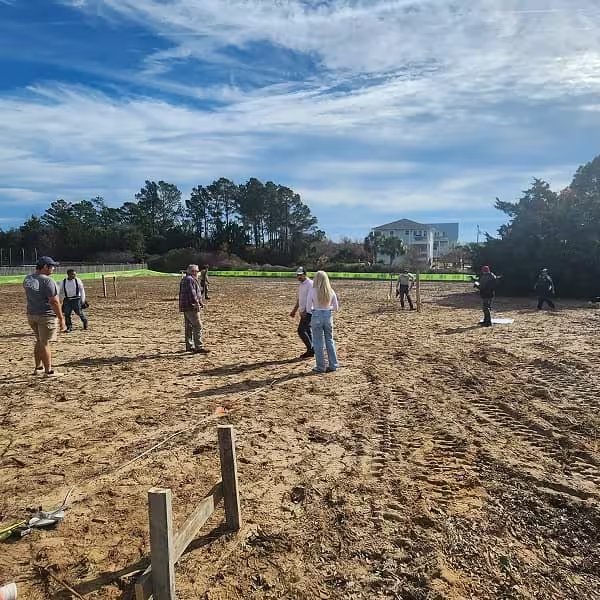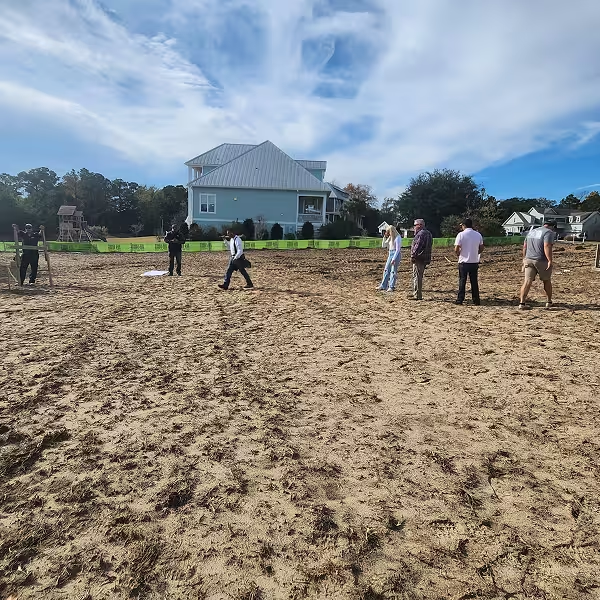Introduction
This week we have started the construction journey of the Lace Oasis Project, a custom home nestled in the picturesque town of Hampstead, NC, the first significant phase unfolds in the meticulous process — digging footers. This crucial step lays the groundwork for the entire structure, symbolizing not only the physical support of the residence but also the foundation upon which dreams are built.
Initial Preparation
As we delved into the project, the topography of the land became a pivotal factor, demanding a strategic approach to laying the foundation that would seamlessly integrate with the slope.
The initial phase involved a meticulous site analysis, where we meticulously surveyed the lot, mapping out the undulating terrain. This step was fundamental in understanding the extent of the elevation changes and informed our decisions on how to adapt the foundation to this dynamic landscape.

Digging a footer
Digging a footer for a home is a crucial step in the construction process, as it involves excavating the ground to create a trench where the foundation will be laid. The purpose of this process is to provide a stable and level base for the building, distributing the weight of the structure evenly and preventing settling or shifting over time. Here's what happens when you dig a footer for a home:
- Site Preparation: Before digging begins, the construction site is prepared by clearing away any vegetation, debris, or obstacles that might interfere with the excavation process.
- Marking and Layout: The layout of the home's foundation, as specified in the architectural plans, is marked on the ground. This includes the dimensions and locations of the footers.
- Excavation: Using heavy equipment such as excavators, backhoes, or trenchers, workers dig trenches to the required depth and width for the footers. The depth of the footer depends on local building codes, soil conditions, and the specific design of the home.
- Soil Analysis: During excavation, soil conditions are closely monitored. The type of soil and its load-bearing capacity are important factors that influence the design of the foundation. In some cases, soil may need to be removed or replaced to ensure stability.
- Footers Construction: Once the trenches are excavated to the appropriate depth, concrete footers are constructed within these trenches. Footers are horizontal supports that run along the base of the foundation walls. They provide a wider surface area to distribute the weight of the structure and prevent settling.
- Reinforcement: Depending on the design and structural requirements, steel reinforcement (rebar) may be added to the footers before pouring concrete. This enhances the strength and stability of the foundation.
- Concrete Pouring: High-quality concrete is poured into the trenches to create the footers. The concrete is leveled and allowed to cure, ensuring that it reaches its full strength.
- Inspecting and Curing: After the concrete is poured, the footers are inspected to ensure they meet the necessary specifications. Proper curing is essential to achieve the desired strength, and this process may take several days.
- Foundation Construction: With the footers in place, the foundation walls can be constructed. The footers provide a solid base for the walls to rest upon, ensuring stability and preventing settling or shifting over time.

Final Thoughts
In the end, navigating the intricacies of laying the foundation on a sloped lot was a testament to the collaborative spirit and adaptability of our team. The final result was not just a building on a slope but a structure seamlessly integrated with the natural contours of the land, a testament to the precision and innovation required when foundations meet elevation challenges.



